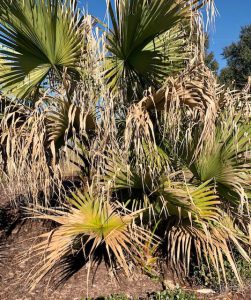Cold damage is inevitable when growing tropical palms in North Florida. Early freezes around Christmas 2022 may have resulted in cold injury to our more cold-sensitive palms. Monica Elliott and Tim Broschat, retired UF/IFAS horticulture researchers who specialized in palms, provide the following tips on coping with cold injured palms.

Wait to remove injured palm leaves that have any green tissue remaining. The damaged leaves may help the palm survive future cold events this winter. Once the palm has produced 2 to 3 new leaves, damaged leaves can be removed.
New palm leaves develop from the bud located in the crown (top) of the plant. It is this bud that needs to be protected. Leaf bases provide insulating protection to this bud. This is one reason not to over trim palms at any time.
As warm weather returns, plant pathogens often attack the cold damaged tissue. Copper fungicides are recommended as an attempt (not a guarantee) to protect the bud and developing leaves from these diseases. There is no research to confirm if this is effective or not. The recommendation is based on observation of cold injured palms and knowledge of fungicides. Usually, it is the base of the spear leaf not yet emerged from the whorl of leaf bases that is damaged first, leading to a spear rot, which may then lead to a bud rot. The goal of a copper fungicide is to prevent this spear rot from developing into a bud rot that kills the bud and palm.
Copper fungicides have activity against both bacteria and fungi. No other fungicides have this broad spectrum of activity. Complete coverage of the base of the spear leaf and bud is a must. This is difficult to accomplish in some palm species with crown shafts because the leaf bases tightly surround the emerging spear leaf, preventing movement of a fungicide into the bud.
If the spear leaf rots and is easily pulled from the bud, remove it immediately, followed by a copper fungicide spray or drench of the now exposed bud region.
Apply the copper fungicides no more than twice because of the possibility of copper phytotoxicity. If additional chemical protection of the bud is needed, a broad-spectrum contact fungicide may be beneficial.
You will not know if the palm survived the cold until new growth emerges, which may be 4 to 7 months later. New growth may be severely malformed or damaged but the emergence of living leaf tissue is a sign the palm is alive. Subsequent leaves will gradually improve in quality but it may take a year before normal leaves emerge.
Always follow directions and precautions when using any pesticide, including copper-based fungicides!
More info on cold injured palms is available at this link: https://edis.ifas.ufl.edu/publication/MG318.
 0
0
